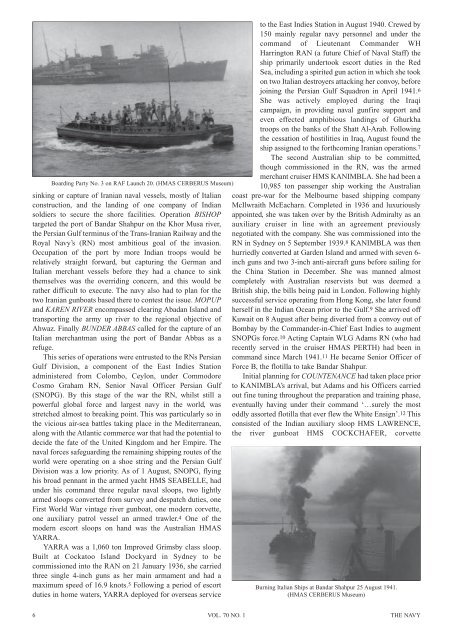The Navy Vol_70_No_1 Jan 2008 - Navy League of Australia
The Navy Vol_70_No_1 Jan 2008 - Navy League of Australia
The Navy Vol_70_No_1 Jan 2008 - Navy League of Australia
- No tags were found...
You also want an ePaper? Increase the reach of your titles
YUMPU automatically turns print PDFs into web optimized ePapers that Google loves.
to the East Indies Station in August 1940. Crewed by150 mainly regular navy personnel and under thecommand <strong>of</strong> Lieutenant Commander WHHarrington RAN (a future Chief <strong>of</strong> Naval Staff) theship primarily undertook escort duties in the RedSea, including a spirited gun action in which she tookon two Italian destroyers attacking her convoy, beforejoining the Persian Gulf Squadron in April 1941.6She was actively employed during the Iraqicampaign, in providing naval gunfire support andeven effected amphibious landings <strong>of</strong> Ghurkhatroops on the banks <strong>of</strong> the Shatt Al-Arab. Followingthe cessation <strong>of</strong> hostilities in Iraq, August found theship assigned to the forthcoming Iranian operations.7<strong>The</strong> second <strong>Australia</strong>n ship to be committed,though commissioned in the RN, was the armedmerchant cruiser HMS KANIMBLA. She had been aBoarding Party <strong>No</strong>. 3 on RAF Launch 20. (HMAS CERBERUS Museum)10,985 ton passenger ship working the <strong>Australia</strong>ncoast pre-war for the Melbourne based shipping companyMcIlwraith McEacharn. Completed in 1936 and luxuriouslyappointed, she was taken over by the British Admiralty as anauxiliary cruiser in line with an agreement previouslynegotiated with the company. She was commissioned into theRN in Sydney on 5 September 1939.8 KANIMBLA was thenhurriedly converted at Garden Island and armed with seven 6-inch guns and two 3-inch anti-aircraft guns before sailing forthe China Station in December. She was manned almostcompletely with <strong>Australia</strong>n reservists but was deemed aBritish ship, the bills being paid in London. Following highlysuccessful service operating from Hong Kong, she later foundherself in the Indian Ocean prior to the Gulf.9 She arrived <strong>of</strong>fKuwait on 8 August after being diverted from a convoy out <strong>of</strong>Bombay by the Commander-in-Chief East Indies to augmentSNOPGs force.10 Acting Captain WLG Adams RN (who hadrecently served in the cruiser HMAS PERTH) had been incommand since March 1941.11 He became Senior Officer <strong>of</strong>Force B, the flotilla to take Bandar Shahpur.Initial planning for COUNTENANCE had taken place priorto KANIMBLA’s arrival, but Adams and his Officers carriedout fine tuning throughout the preparation and training phase,eventually having under their command ‘…surely the mostoddly assorted flotilla that ever flew the White Ensign’.12 Thisconsisted <strong>of</strong> the Indian auxiliary sloop HMS LAWRENCE,the river gunboat HMS COCKCHAFER, corvettesinking or capture <strong>of</strong> Iranian naval vessels, mostly <strong>of</strong> Italianconstruction, and the landing <strong>of</strong> one company <strong>of</strong> Indiansoldiers to secure the shore facilities. Operation BISHOPtargeted the port <strong>of</strong> Bandar Shahpur on the Khor Musa river,the Persian Gulf terminus <strong>of</strong> the Trans-Iranian Railway and theRoyal <strong>Navy</strong>’s (RN) most ambitious goal <strong>of</strong> the invasion.Occupation <strong>of</strong> the port by more Indian troops would berelatively straight forward, but capturing the German andItalian merchant vessels before they had a chance to sinkthemselves was the overriding concern, and this would berather difficult to execute. <strong>The</strong> navy also had to plan for thetwo Iranian gunboats based there to contest the issue. MOPUPand KAREN RIVER encompassed clearing Abadan Island andtransporting the army up river to the regional objective <strong>of</strong>Ahwaz. Finally BUNDER ABBAS called for the capture <strong>of</strong> anItalian merchantman using the port <strong>of</strong> Bandar Abbas as arefuge.This series <strong>of</strong> operations were entrusted to the RNs PersianGulf Division, a component <strong>of</strong> the East Indies Stationadministered from Colombo, Ceylon, under CommodoreCosmo Graham RN, Senior Naval Officer Persian Gulf(SNOPG). By this stage <strong>of</strong> the war the RN, whilst still apowerful global force and largest navy in the world, wasstretched almost to breaking point. This was particularly so inthe vicious air-sea battles taking place in the Mediterranean,along with the Atlantic commerce war that had the potential todecide the fate <strong>of</strong> the United Kingdom and her Empire. <strong>The</strong>naval forces safeguarding the remaining shipping routes <strong>of</strong> theworld were operating on a shoe string and the Persian GulfDivision was a low priority. As <strong>of</strong> 1 August, SNOPG, flyinghis broad pennant in the armed yacht HMS SEABELLE, hadunder his command three regular naval sloops, two lightlyarmed sloops converted from survey and despatch duties, oneFirst World War vintage river gunboat, one modern corvette,one auxiliary patrol vessel an armed trawler.4 One <strong>of</strong> themodern escort sloops on hand was the <strong>Australia</strong>n HMASYARRA.YARRA was a 1,060 ton Improved Grimsby class sloop.Built at Cockatoo Island Dockyard in Sydney to becommissioned into the RAN on 21 <strong>Jan</strong>uary 1936, she carriedthree single 4-inch guns as her main armament and had amaximum speed <strong>of</strong> 16.9 knots.5 Following a period <strong>of</strong> escortduties in home waters, YARRA deployed for overseas serviceBurning Italian Ships at Bandar Shahpur 25 August 1941.(HMAS CERBERUS Museum)6 VOL. <strong>70</strong> NO. 1 THE NAVY
















